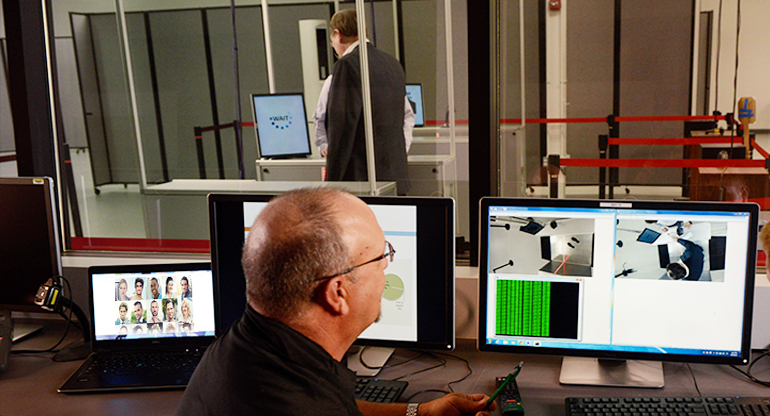 04-30-2019
04-30-2019
SAIC lab proves out identity technologies vital to our safety and security
Every day, Department of Homeland Security officers across the U.S. rely on technology tools to inspect or screen more than 2 million air travelers, including biometrics. SAIC’s Identity and Data Sciences Lab (IDSL) puts these technologies through their paces at our Maryland Test Facility (MdTF), ensuring they will perform as advertised.
Sponsored by DHS’s Science and Technology Directorate (DHS S&T), our lab provides independent testing and evaluation of commercial biometric products for DHS and its components such as Customs and Border Protection and the Transportation Security Administration.
As a trusted partner between biometric technology vendors and federal government users, the IDSL team at the MdTF:
- Recruits and hosts a diverse population who give their consent to try out new technologies.
- Evaluates biometric sensors and algorithms to see how effectively, efficiently, and equitably they collect and handle data.
- Examines human factors--whether volunteers are receptive and responsive to the technologies.
- Determines how well the technologies stand up to real-world operating conditions. Our IDSL team also plans and conducts pilot projects and field tests.
- Develops the concepts of operations, or CONOPS, for biometric operations.
- Briefs customers on product test results and expedites knowledge sharing across government and industry.
“We are a proving ground, helping DHS understand which biometric technologies will work in public-facing environments,” said Jerry Tipton, SAIC program manager and IDSL's director. “DHS S&T shares our reports with DHS components and other federal agencies like the FBI, and once the information is made public, vendors use it to improve their products.”
Making security efficient and reliable
DHS is deploying biometric technologies, like face recognition, to modernize security and improve the passenger experience not just at airports but also at land crossings and seaports. Security officers will benefit from more automated and robust verification processes to meet evolving threats and rising travel volumes.
The IDSL team at the MdTF is at the forefront supporting these initiatives. It has worked with face, fingerprint, and iris recognition systems now in use, and serves as a trusted third-party expert in biometric sensors and algorithms, data analytics, and human factors in the testing and evaluation (T&E) services market.
Tipton credits the IDSL’s success to the robust T&E processes and infrastructure that the team of data scientists, neuroscientists, human factors experts, software engineers, and systems engineers—many with intelligence community, Department of Defense, and DHS backgrounds—has built up.
Together, they answer queries about a device or system that could include:
- How fast and accurately does it gather biometric information?
- How well does it perform at different times of the day, under various conditions?
- Does the technology integrate into a security officer’s existing screening or inspection process? Will it perform in an updated process either staffed or unstaffed?
- How will it be accepted by the public? Is it intuitive or intimidating?
All of these are real-world factors on the throughput of hundreds of millions of travelers screened or inspected by DHS. As the majority of travelers does not pose security risks, DHS is sensitive to expediting screenings while ensuring security.
We have been a longtime, responsible biometrics advisor to DHS. To date, our 24,000-square-foot facility has welcomed over 3,100 volunteers from 75 countries of origin across five continents to provide their input on identification technologies.
The MdTF hosts a variety of small to big T&E projects each year. Large-scale evaluations can last several months and involve a group of products from multiple vendors.
The goal of each test, however, is the same: enhance DHS security operations and make the process as, equitable, efficient, and hassle-free as possible for citizens.
FURTHER READING: Read about our other activities involving data science and analytics.
MetaSift Speeds Training Analytics
Data Analytics: A Broker of Efficiency




